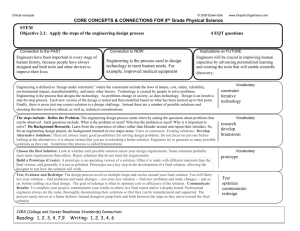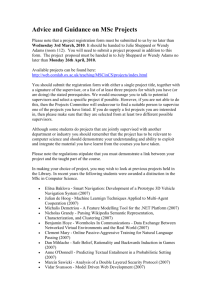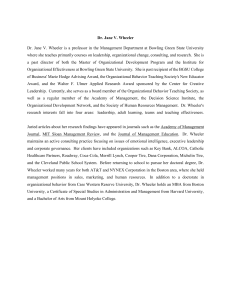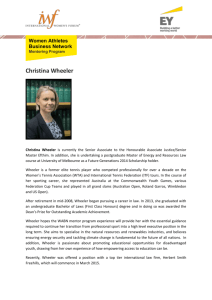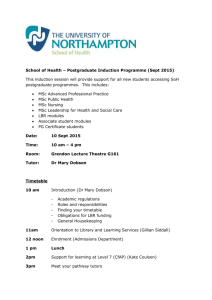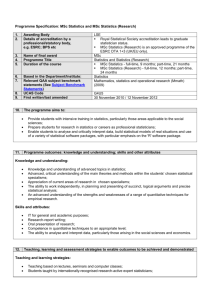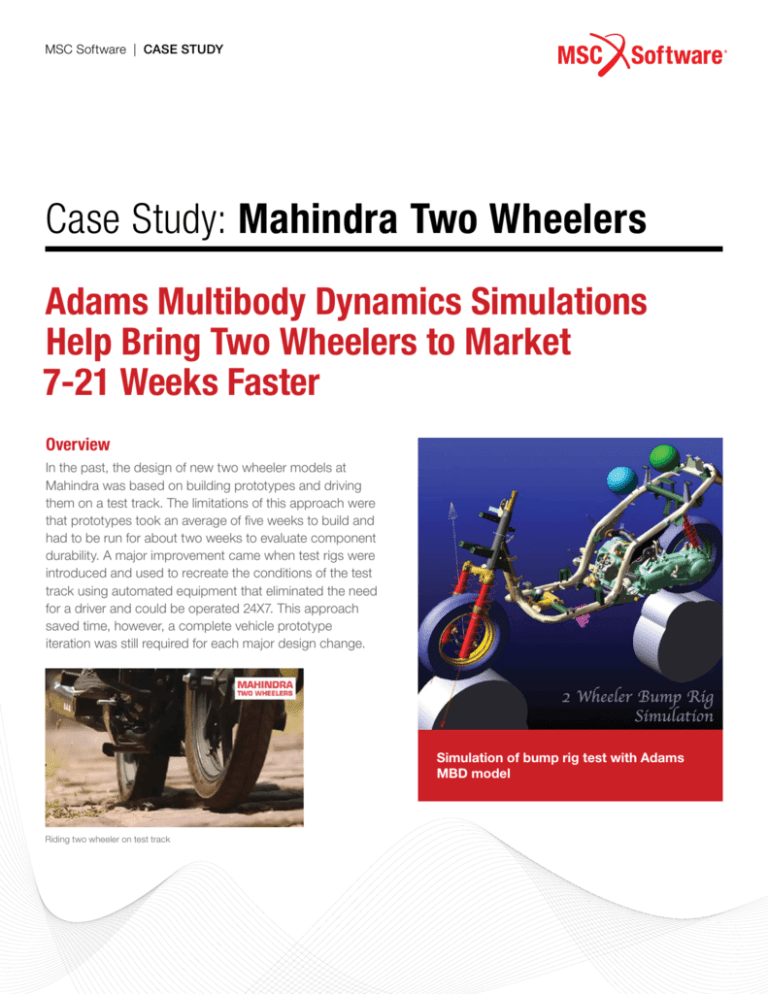
MSC Software | CASE STUDY
Case Study: Mahindra Two Wheelers
Adams Multibody Dynamics Simulations
Help Bring Two Wheelers to Market
7-21 Weeks Faster
Overview
In the past, the design of new two wheeler models at
Mahindra was based on building prototypes and driving
them on a test track. The limitations of this approach were
that prototypes took an average of five weeks to build and
had to be run for about two weeks to evaluate component
durability. A major improvement came when test rigs were
introduced and used to recreate the conditions of the test
track using automated equipment that eliminated the need
for a driver and could be operated 24X7. This approach
saved time, however, a complete vehicle prototype
iteration was still required for each major design change.
Simulation of bump rig test with Adams
MBD model
Riding two wheeler on test track
“The number of prototypes required to bring a new two wheeler to market has been
reduced from 4 or 5 in the past to 2 or 3 now. The time to build and test a new
prototype is about 7 weeks so the company has been able to bring new two wheels
to market at least 7 to 21 weeks faster than was possible in the past”
Mihir Bhambri, CAE MBD analyst, Mahindra 2 wheelers
Challenge
Solution/Validation
Mahindra’s engineering management
wanted to bring new two wheeler designs
to market faster. The company wanted to
use computer simulation to evaluate the
kinematics of the vehicle and calculate
loads for individual components that could
be exported to finite element analysis
(FEA) software for stress analysis. Another
desired option was to use a flexible body
in the dynamics simulation so that stress
at critical locations could be determined
directly. Achieving these goals required a
multibody dynamics (MBD) software package
that could accurately predict the behavior
of the two wheeler on the test track.
Mahindra selected MSC Software’s Adams,
the most widely used MBD software for
over three decades. MSC Software is
the world leader in both MBD and FEA
software. Speaking the language of both
domains gives MSC the capability to
develop the rich data transfer required to
fully integrate them. Mahindra has evolved
a new virtual testing design process that
uses Adams to simulate the performance
of new designs and accurately predict their
performance prior to the prototype phase.
The new process begins when designers
create the initial concept design of a new
two wheeler using computer aided design
software. Engineers import the design
into Adams and create an MBD model
by defining connectivity, mass properties,
forces and the dynamics input and output of
the two wheeler. Rigid bodies are typically
used at this stage except on components
with multiple joints where flexible bodies
are used to avoid redundancies.
The simulation provides detailed information
on the behavior of every aspect of the two
wheeler that is included in the model. This
information is often used by engineers to
understand the reasons why one design
performed better than another. It’s important
to note that simulation provides much more
diagnostic information than can be obtained
from physical testing which is limited by
the relatively small number of sensors that
can be positioned on the two wheeler.
Key Highlights:
Product: Adams
Industry: Automotive
Benefits:
•Simulation provides much more
diagnostic information than can
be obtained from physical testing
Bump rig test duplicates test track
•Engineers perform parametric
analyses to investigate the
influence of design variables such
as the location of hard points on
accelerations
•Excellent correlation between
simulation and measurements on
suspension systems
•The number of prototypes required to bring a new two wheeler
to market has been reduced from
4 or 5 in the past to 2 or 3 now
•Adams bring new two wheels
to market at least 7 to 21 weeks
faster than was possible in the
past
Rough Road Riding Test using Adams
While the multibody dynamics model is being
created, the company also builds a rough
prototype for use in validating the model. The
prototype is run on a test rig and engineers
compare maximum, minimum and root mean
square (RMS) loads on critical components
for the prototype and model. The loads
predicted by the model normally match those
measured on the prototype within 10%. When
this level of accuracy is achieved, the model
is considered validated and used to drive
the design process from that point forward.
Engineers then utilize the MBD model to
make improvements on the initial conceptual
design. Their primary focus is controlling
acceleration levels at hard points such as
where the engine attaches to the frame.
Accelerations at these points are important
because they generate load and fatigue.
Engineers perform parametric analyses
to investigate the influence of design
variables such as the location of hard points
on accelerations. Engineers identify the
combination of values of the design variables
that reduce accelerations and loads to
minimum values. The design optimization
process typically takes three days including
defining the model variables and constraints
and results interpretation. The loads on
key components predicted by the Adams
analysis are passed to the durability team
who uses these loads as input for FEA.
Engineers then ask the opinion of the stylists
and manufacturing engineers to determine
whether the optimum values are desirable
and feasible and make changes if needed.
This consultation process takes another
two weeks on average. The next step is
to modify the prototype to match the final
design as determined by simulation. Road
testing is then performed on the prototype.
If a component fails prematurely, the
components are examined to determine the
cause of the failure and changes are made
to the design. In the vast majority of new
products, the design developed during the
simulation process works fine and is used
as the final design. The final preproduction
model is then built from scratch and given
to test drivers and customers to evaluate
if there are any concerns on the rough
road and handling test. If changes are
needed, engineers modify the design and
use the MBD model to recheck the loads.
Results
Basing the design process on simulation
rather than testing provides substantial
time and cost savings. The largest savings
come from being able to evaluate alternative
designs without having to build a prototype.
The number of prototypes required to bring a
new two wheeler to market has been reduced
from 4 or 5 in the past to 2 or 3 now. The time
to build and test a new prototype is about
7 weeks so the company has been able to
bring new two wheels to market at least 7 to
21 weeks faster than was possible in the past.
About Mahindra
Correlation between MBD simulation and testing on rear suspension
Founded in 1945 as a steel trading
company, Mahindra entered automotive
manufacturing in 1947 to bring the Willys
Jeep onto Indian roads. Over the years, the
company has diversified into many new
businesses. Today it has US $16.7 billion in
revenues and more than 180,000 employees
in over 100 countries. The Mahindra Two
Wheelers Ltd. product line includes the
Centuro and Pantero motorcycles and
Rodeo RZ, Duro DZ and Flyte scooters.
Correlation between MBD simulation and testing on front suspension
“It’s important to note that simulation provides much more diagnostic information
than can be obtained from physical testing which is limited by the relatively small
number of sensors that can be positioned on the two wheeler.”
For more information on Adams and for additional Case Studies, please visit www.mscsoftware.com/adams
Corporate
MSC Software Corporation
4675 MacArthur Court
Suite 900
Newport Beach, CA 92660
Telephone 714.540.8900
www.mscsoftware.com
Europe, Middle East,
Africa
MSC Software GmbH
Am Moosfeld 13
81829 Munich, Germany
Telephone 49.89.431.98.70
Japan
MSC Software LTD.
Shinjuku First West 8F
23-7 Nishi Shinjuku
1-Chome, Shinjuku-Ku
Tokyo, Japan 160-0023
Telephone 81.3.6911.1200
Asia-Pacific
MSC Software (S) Pte. Ltd.
100 Beach Road
#16-05 Shaw Towers
Singapore 189702
Telephone 65.6272.0082
The MSC Software corporate logo, MSC, and the names of the
MSC Software products and services referenced herein are trademarks
or registered trademarks of the MSC.Software Corporation in the United
States and/or other countries. All other trademarks belong to their
respective owners. © 2014 MSC.Software Corporation. All rights reserved.
MAHINDRA*2014JUN*CS

